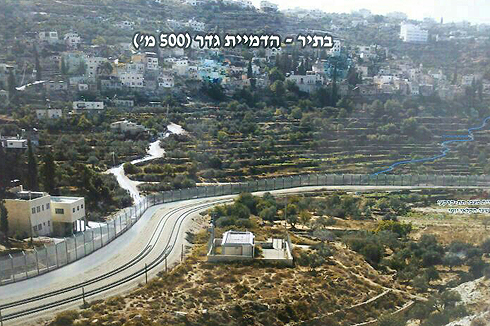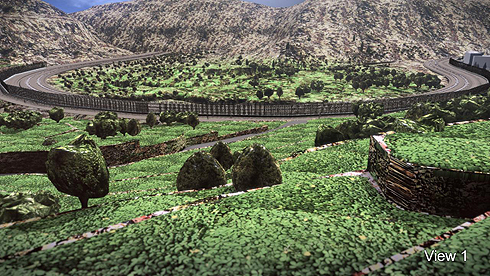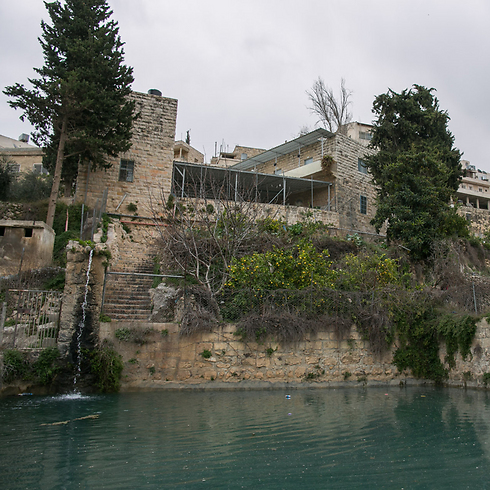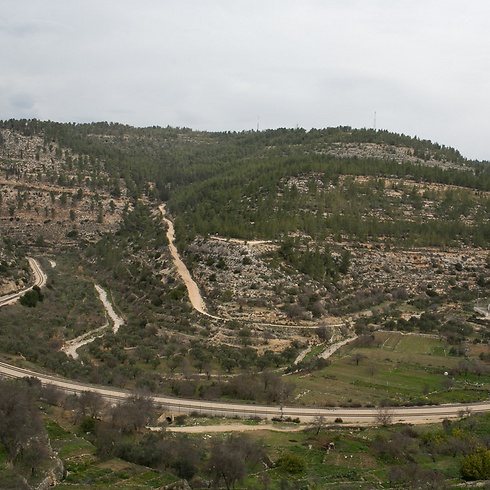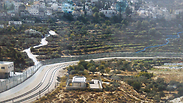
The battle over the Jerusalem separation fence
Security fence will destroy unique landscape, ancient irrigation system, say residents, nature organizations. Defense official: 'The terraces will not be destroyed'
The landscape seen from Battir, an Arab village southwest of Jerusalem, is one of a kind. The town rests on the peak of a mountain, and beneath it lies a valley of terraced landscape that draws its water the same way it has been doing for thousands of years – from a downstream current, then making its way to the agricultural fields being dispersed by Roman irrigation channels.
The ancient system channels water from natural springs down stone terraces and through sluice gates to water villagers' orchards and gardens.
Battir's produce is a key source of income for the village, as is the tourism generated by the Roman irrigation system itself, a proposed UNESCO world heritage site that attracts Holy Land visitors and historians.
The beauty of the natural surroundings, however, can only stand by and watch in the current conflict of the building of a security fence adjacent to the village. Residents say that a fence would destroy the ancient terraces.
The High Court of Justice was to decide on Wednesday if the residents' claim, filed in partnership with the organization Friends of the Earth and the Parks and Nature Authority, if the State will be permitted to build a security fence there.
The Defense Ministry's initial plan was to construct a three kilometer-long cement wall in the area and a tall wired fence along the rest of the area. The wall was planned in order to protect the tracks for the new Jerusalem-Tel Aviv train, which initially was supposed to run along the terraces and the valley on existing track. Those plans have changed, however, and the new train, scheduled to begin operations in 2017, will run along a different track in a different area.
The Defense Ministry then changed its plan, and decided that it would cancel the cement wall and only establish a wired fence along the length of the valley.
Last year, the ministry began preparing the area for initial work to be done, but after the appeal to the High Court was filed it was forced to halt all operations. The court also demanded that the ministry explain why the fence couldn't be established in a different part of the region.
Taking the high road
The residents of Battir, meanwhile, decided to take the high road when it came to opposing the fence, not like their northern cousins in the villages of Bil'in and Ni'lin.
"We don't need a popular resistance. We have the Israeli court and we trust its judgment," the regional council head, Akram Bader, said. "We want peace and quiet, just as it has been preserved here for many years, and we've respected that tradition, and therefore, there is no reason for there to be a fence for security reasons. Anyone who has tried to disturb that balance in the past has been stopped by us."
Related stories:
- Separation barrier threatens to split West Bank villages
- Rockets and tunnels: Hamas preparing for next conflict
- Palestinian police, refugee camp residents clash over UN strike
Despite the lack of violence and protests, which has raised eyebrows within the larger Palestinian community, Bader also said that even if the High Court ruling goes against them they will continue to protest non-violently.
Friends of the Earth Middle East CEO Gidon Bromberg said the state has to pay attention to considerations other than security.
"Even though the terraces in Battir aren't well-known by many Israelis, we're talking about a unique heritage site on an international level that every effort needs to be done in order to protect it, regardless of where it's located on the border," he said. "There are alternative courses for the fence and we hope that the High Court of Justice will accept our stance and the Nature and Parks Authority's stance, and that the building of the fence will preserve this unique site."
Nature will not be destroyed
A defense official said that the Defense Ministry took into consideration the uniqueness of the nature, and that only one terrace would be damaged and after which it would be repaired.
The source also said that the fence wouldn't be taller than three meters.
"There is no connection between the artist's renditions to the reality. The terraces will not be destroyed, nor will the traditional irrigation system be destroyed."
Despite the residents' claims, the source said many Palestinians infiltrate Israel coming from the village's region. The proposed replacement of a shorter fence with more cameras wasn't approved by the ministry due to security objections, the official said.










